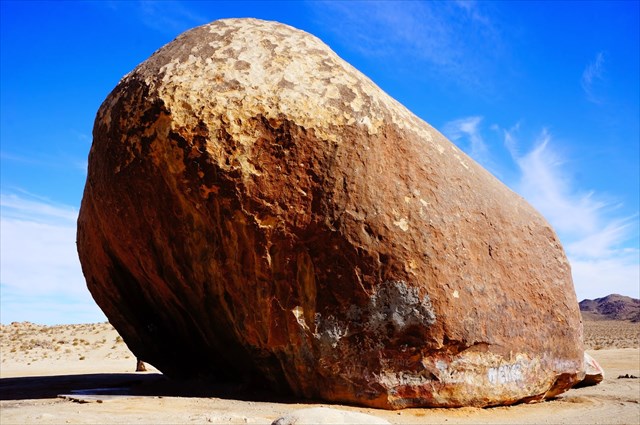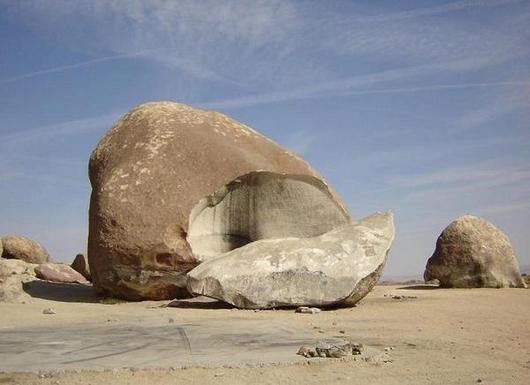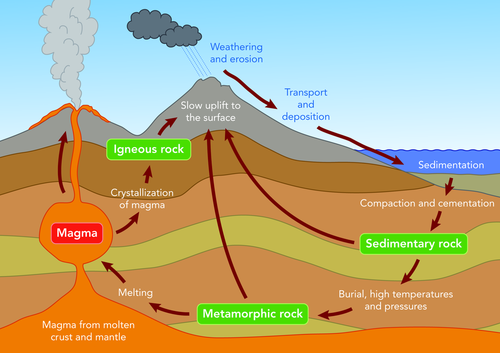|
![]()

Across the world many giant rock formations are causing mouths to drop because of incredible amazement just from their size. A boulder is nothing but a giant rock…right? Now how big can giant be? Welcome to Giant Rock!
![]()
The fabled Giant Rock is thought to be the world's largest freestanding boulder --- at about seven stories high, between 25,000 and 30,000 tons, covers 5,800 square feet (540 m2) of ground and is made completely of granite. Geologists consider Giant Rock to be an "erratic" deposited during the last Ice Age." It is estimated to be 65 and 135 million years old. An erratic is a piece of rock that differs from the size and type of rock native to the area in which it rests.
![]()

There are some rocks on our planet that leave most people in awe. Some, due to their beauty. Some, due to their uniqueness. To me, Giant Rock is both. The three classes of rocks are igneous rocks, sedimentary rocks and metamorphic rocks. Igneous rocks are created below the earth’s surface as it is started as magma also known as a melted rock; a melted rock that cools from the inside slowly cools from melted to a solid becomes a rock. Sediments are fragments found at the bottom of lakes, rivers, or the sea that consist of shells, stones, or plants which are forced together forming a solid rock. Metamorphic rocks are created by the heat and intense pressure beneath the earth’s crust causing an igneous or a sediment rock to be morphed to other minerals and shapes.
![]()

Granite is a common type of intrusive, felsic, igneous rock which is granular and phaneritic in texture. Phaneritic is a term usually used to refer to igneous rock grain size. It means that the size of matrix grains in the rock are large enough to be distinguished with the unaided eye as opposed to aphanitic (which is too small to see with the naked eye). This texture forms by slow cooling of magma deep underground in the plutonic environment.
![]()
Granite rock consists mainly of quartz, mica, and feldspar. Granites can be pink to grey in colour, depending on their chemistry and mineralogy. By definition, granite is an igneous rock with at least 20% quartz by volume.
![]()

Granite is classified according to the QAPF diagram for coarse grained plutonic rocks and is named according to the percentage of quartz, alkali feldspar and plagioclase feldspar. True granite according to modern petrologic convention contains both plagioclase and alkali feldspars. When a granitoid is devoid or nearly devoid of plagioclase, the rock is referred to as alkali granite. When a granitoid contains less than 10% orthoclase, it is called tonalite.
![]()

Granite is currently known only on Earth, where it forms a major part of continental crust. Granite has been intruded into the crust of the Earth during all geologic periods, although much of it is of Precambrian age. Granitic rock is widely distributed throughout the continental crust and is the most abundant basement rock that underlies the relatively thin sedimentary veneer of the continents. Granite is an igneous rock and is formed from magma. Presence of water is required for the formation of granite from basalt.
![]()
To log a find on this cache, you must E-MAIL me the correct answers. If any of your answers are wrong, I will email you and let you know.
![]()
1. Put "Giant Rock - Landers, California" in the subject line of your email.
![]()
2. Geologists consider Giant Rock to be an "erratic". What natural force causes erratics to be moved to their final location?
![]()
3. True or false. It is possible that some erratics were moved hundreds of miles before they were deposited at their present location?
![]()
4. When Giant Rock split in 2000, we finally got to see the inside of it? Describe the color and texture of the inside.
![]()
5. Of the three types of rock mention above, what type do you think Giant Rock is and why?
![]()
6. On the north-west side, on the bottom half of Giant Rock, there is a color on the rock that is different than near the top. What color is it and what do you think caused the color?
![]()
7. Optional: Post a picture of you at the rock.
![]()
Works Cited
https://en.wikipedia.org/wiki/Granite
![]()
https://en.wikipedia.org/wiki/Giant_Rock
![]()
http://www.askthebuilder.com/weight-of-giant-rock-in-ca/
![]()
https://www.hcn.org/issues/41.21/erratic-behavior
![]()
http://www.lucernevalley.net/giantrock/
![]()
http://www.oocities.org/sptmbrmrn/101501.htm
![]()
http://geology.com/rocks/granite.shtml
![]()
|